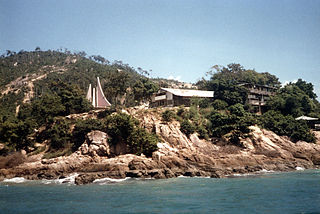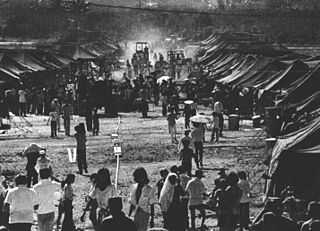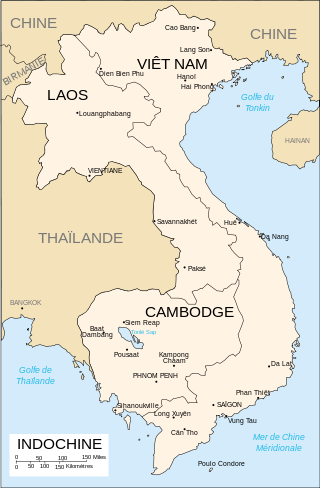
The Laotian Civil War (1959–1975) was a civil war in Laos waged between the Communist Pathet Lao and the Royal Lao Government from 23 May 1959 to 2 December 1975. It is associated with the Cambodian Civil War and the Vietnam War, with both sides receiving heavy external support in a proxy war between the global Cold War superpowers. It is known as the Secret War among the American CIA Special Activities Center, and Hmong and Mien veterans of the conflict.

Vietnamese Americans are Americans of Vietnamese ancestry. They comprise approximately half of all overseas Vietnamese and are the fourth-largest Asian American ethnic group following Chinese Americans, Indian Americans, and Filipino Americans. There are approximately 2.3 million people of Vietnamese descent residing in the U.S. as of 2023.

The Cambodian Civil War was a civil war in Cambodia fought between the forces of the Communist Party of Kampuchea against the government forces of the Kingdom of Cambodia and, after October 1970, the Khmer Republic, which had succeeded the kingdom.

The Humanitarian Service Medal (HSM) is a military service medal of the United States Armed Forces which was created on January 19, 1977 by President Gerald Ford under Executive Order 11965. The medal may be awarded to members of the United States military who distinguish themselves by meritorious participation in specified military acts or operations of a humanitarian nature.
NghiaSinh International, also known as the International Volunteers for Human Service and Leadership Development, is a humanitarian organization founded in June 1963 in Saigon to provide emergency assistance to the elderly and the poor who arrived in Saigon as refugees from the countryside of Vietnam.

Bidong Island is an island in Kuala Nerus District, Terengganu, Malaysia in the South China Sea. Bidong Island is accessible from the coastal town of Merang in Setiu district. From 1978 until 2005 Bidong Island was a refugee camp with a population reaching at its peak as many as 40,000 Vietnamese refugees. A total of about 250,000 refugees were residents of the camp during the period of its operation. Most stayed on Bidong a few months or longer and were resettled abroad in third countries, especially the United States.

Operation New Life was the care and processing on Guam of Vietnamese refugees evacuated before and after the Fall of Saigon, the closing day of the Vietnam War. More than 111,000 of the evacuated 130,000 Vietnamese refugees were transported to Guam, where they were housed in tent cities for a few weeks while being processed for resettlement. The great majority of the refugees were resettled in the United States. A few thousand were resettled in other countries or chose to return to Vietnam on the vessel Thuong Tin.

Operation Passage to Freedom was a term used by the United States Navy to describe the propaganda effort and the assistance in transporting in 310,000 Vietnamese civilians, soldiers and non-Vietnamese members of the French Army from communist North Vietnam to non-communist South Vietnam between the years 1954 and 1955. The French and other countries may have transported a further 500,000. In the wake of the French defeat at the Battle of Dien Bien Phu, the Geneva Accords of 1954 decided the fate of French Indochina after eight years of war between the French Union forces and the Viet Minh, which fought for Vietnamese independence under communist rule. The accords resulted in the partition of Vietnam at the 17th parallel north, with Ho Chi Minh's communist Viet Minh in control of the north and the French-backed State of Vietnam in the south. The agreements allowed a 300-day period of grace, ending on May 18, 1955, in which people could move freely between the two Vietnams before the border was sealed. The partition was intended to be temporary, pending elections in 1956 to reunify the country under a national government. Between 600,000 and one million people moved south, including more than 200,000 French citizens and soldiers in the French army while between 14,000 and 45,000 civilians and approximately 100,000 Viet Minh fighters moved in the opposite direction.

Formal relations between the United States and Vietnam were initiated in the nineteenth century under former American president Andrew Jackson, but relations soured after the United States refused to protect the Kingdom of Vietnam from a French invasion.

Relations between Laos and the United States officially began when the United States opened a legation in Laos in 1950, when Laos was a semi-autonomous state within French Indochina. These relations were maintained after Laos' independence in October 1953.

1975 marked the end of the Vietnam War. The North Vietnamese People's Army of Vietnam (PAVN) launched the Spring Offensive in March; the South Vietnamese Army of the Republic of Vietnam (ARVN) was quickly defeated. The North Vietnamese captured Saigon on April 30, accepting the surrender of South Vietnam. In the final days of the war, the United States, which had supported South Vietnam for many years, carried out an emergency evacuation of its civilian and military personnel and more than 130,000 Vietnamese.

Vietnamese boat people were refugees who fled Vietnam by boat and ship following the end of the Vietnam War in 1975. This migration and humanitarian crisis was at its highest in 1978 and 1979, but continued into the early 1990s. The term is also often used generically to refer to the Vietnamese people who left their country in a mass exodus between 1975 and 1995. This article uses the term "boat people" to apply only to those who fled Vietnam by sea.

Julia Ann Vadala Taft was a United States official who was involved in international humanitarian assistance, and who served as Director of the Office of Foreign Disaster Assistance from 1986 to 1989, and as Assistant Secretary of State for Population, Refugees, and Migration from 1997 to 2001.
Jerrold B. Daniels or Jerry Daniels was a CIA Paramilitary Operations Officer (PMOO) in their Special Activities Center who worked in Laos and Thailand from the early 1960s to the early 1980s. He was known by his self-chosen CIA call-sign of "Hog." In the early 1960s, he was recruited by the CIA as a liaison officer between Hmong General Vang Pao and the CIA. He worked with the Hmong people for the CIA's operation in Laos commonly called the "Secret War" as it was little known at the time. In 1975, as the communist Pathet Lao and North Vietnamese Army advanced on the Hmong base at Long Tieng, Daniels organized the air evacuation of Vang Pao and more than two thousand of his officers, soldiers, and their families to Thailand. Immediately after the departure of Daniels and Vang Pao, thousands more Hmong fled across the Mekong river to Thailand, where they lived in refugee camps. From 1975 to 1982 Daniels worked among Hmong refugees in Thailand facilitating the resettlement of more than 50,000 of them in the United States and other countries.

The Indochina refugee crisis was the large outflow of people from the former French colonies of Indochina, comprising the countries of Vietnam, Cambodia, and Laos, after communist governments were established in 1975. Over the next 25 years and out of a total Indochinese population in 1975 of 56 million, more than 3 million people would undertake the dangerous journey to become refugees in other countries of Southeast Asia, Hong Kong, or China. According to the United Nations High Commissioner for Refugees, 250,000 Vietnamese refugees had perished at sea by July 1986. More than 2.5 million Indochinese were resettled, mostly in North America, Australia, and Europe. More than 525,000 were repatriated, either voluntarily or involuntarily, mainly from Cambodia.
The Cambodian humanitarian crisis from 1969 to 1993 consisted of a series of related events which resulted in the death, displacement, or resettlement abroad of millions of Cambodians.

The Vietnam Humanitarian Assistance and Evacuation Act of 1975 was U.S. congressional legislation that proposed to designate financial resources for the evacuation and humanitarian aid of South Vietnam preceding the Fall of Saigon. The Act was not passed, however, it began the debate in Congress over how best to evacuate Vietnam and the extent of the President's power to use military troops in order to safely evacuate refugees. These conversations led to the Indochina Migration and Refugee Assistance Act which was introduced shortly after H.R. 6096 failed to pass.

Lionel Alexander Rosenblatt is a former American diplomat, Refugee Coordinator at the United States Embassy in Thailand, and President of Refugees International, an advocacy organization for refugees. Rosenblatt was one of the foremost advocates for resettling Indochinese refugees in the United States during the 1970s and 1980s.

The United States foreign policy during the 1974–1977 presidency of Gerald Ford was marked by efforts to de-escalate the Cold War. Ford focused on maintaining stability and promoting détente with the Soviet Union. One of Ford's key foreign policy achievements was the signing of the Helsinki Accords in 1975. The accords were a series of agreements between the US, Soviet Union, and other European countries that aimed to promote human rights, economic cooperation, and peaceful relations between East and West. Ford met with Soviet leader Leonid Brezhnev several times, and the two countries signed the Strategic Arms Limitation Talks in 1979, which aimed to limit the number of nuclear weapons held by the two superpowers.
The following is a timeline of the presidency of Gerald Ford from January 1, 1975, to December 31, 1975.
















